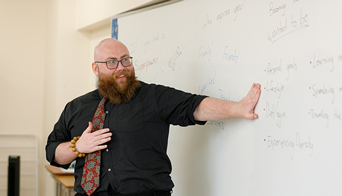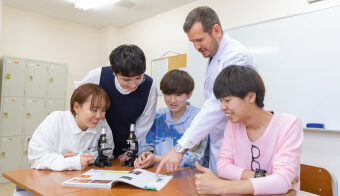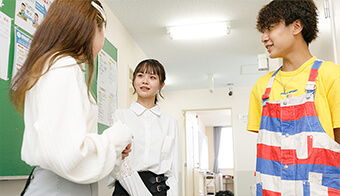ブログ
2020.07.29 先生のつぶやき
夏祭りと国際理解
新型コロナ感染防止のため、今年はさまざまなイベントが姿を消し、大阪にいる私たちが楽しみにしていた天神祭の船渡御やPLの花火、岸和田のだんじりも中止が決定されました。各地の盆踊りもなくなりますね。
ところで、「祭り」は何のために行われるのでしょう。
メキシコ流お盆「Dia de los Muertos」
以前勤めていた学校で、アメリカにあるESL(English as the Second Language)のクラスと交流活動をしていたのですが、あるとき、メキシコ出身の生徒が以下のようなお手紙を送ってくれました。
Hi! Today I’m going to talk about “Dia de los Muertos”. It’s a Mexican holiday when we go to the cemetery to clean and decorate our ancestors’ graves. It’s very important for the people who live there because the people who died are very special for them. Sometimes they fill eggs with confetti and throw them at people. Then we go downtown and people dance. Sometimes they throw fireworks and money. At the end of the two days, people eat “Pan de Muerto”.
It takes place on the 1st and 2nd of November. The first day is called “Dia de los Angellitos” and the second “Baile de los Muertos”. After those two days, people give out free Pan de Muerto that they didn’t sell. The Pan de Muerto is special because it is fancy and has a different shape. They make the bread with flour and sugar, then sometimes they put caramel on the bread.
Today, people wear wooden skull masks called “calacas” and dance in honor of their dead relatives. The wooden skulls are also placed on altars for the dead. Sugar skulls, with the names of the dead person, are eaten by relatives and friends. It is not a scary holiday like Halloween.
Mexican people believe that death is just a process in the life cycle and that it brings peace to the person’s soul. It is a day to remember loved ones. It comes from Aztec culture, Native American from Mexico. Marigolds are the flowers of the dead, and people burn copal or incense.

皆さんの中には「リメンバー・ミー」という映画を見て、このお祭りのことを知った人もいるのではないでしょうか。
当時(「リメンバー・ミー」の上映より3年ほど前でした)担当していた生徒たちは、この手紙を読んで、口々に言い始めました。「ガイコツ飾る、とか日本ではせぇへんよなぁ。」、「ガイコツのお面で踊ったら、ちょっとこわくない?」、「でも、日本のお盆と似てるんちゃう?」
日本のお盆と異国の文化
そこで、日本の「お盆」についてみんなで意見を出し合って、相手の学校に送ったのが次の英文です。
O-bon is a Japanese festival in summer. Every family welcomes back its ancestors’ souls to this world from August 13th through 15th. Because the spirits of the dead return during this time, people light fires at the entrances to homes so the spirits do not lose their way. People tidy up the Buddhist home altars and set out offerings, such as vegetables and fruit.
People enjoy Bon Dance in their hometown around this time of the year. It was originally a religious ceremony to entertain ancestors’ spirits, but today it is a local event for families.
At the end of o-bon, the spirits go back to the other world. People light fires at entrances of homes to see off the spirits, and float the offerings on rivers.
O-bon is a Buddhist festival and originally it’s religious. You should go to a cemetery and visit your ancestor’s grave. But today O-bon is becoming just a holiday. Many companies and stores are closed during the O-bon holiday. People come back to their hometown and get together with their family and friends. Some people go on a vacation to the beach, to the mountains, or abroad. Railroad stations and airports are packed with travelers.
面白いと思ったのは、日本の「お盆」について書こうとすると、「みんな知っているはずの日本の文化でも知らなかったことがたくさんある」と気づいたことと、「遠い国の文化と以外に多くの共通点がある」ということでした。
生徒たちの気づいた共通点:
①家族が集まる休日
②亡くなった人に敬意を払い、お墓をきれいにする
③household altar(祭壇、仏壇)がある
④お香を焚く
⑤亡くなった人の霊を慰めるために踊る
⑥「迎え火」「送り火」(花火)
などなど。
アメリカでは子供たちも当然英語を話している、と思い込んでいた生徒たちにとっては、英語を第二言語として学んでいる子供たちとの交流が新鮮だったし、その子たちの文化を知ることで、自文化についても考えるいい機会となりました。
さて、いよいよ夏本番! 今年の「お盆」は家族と共に祖先の霊を慰めながら、遠い国々の文化に思いを馳せてみましょうか!?

3年生担任・英語科教員 南 美佐江
↓本校HPはこちら

大阪のインターナショナルスクールなら
関西インターナショナルハイスクール
〒545-00053 大阪市阿倍野区松崎町2-9-36
帰国生・帰国子女受け入れ校
高校卒業資格(2019年4月より併修先の高校がNHK学園高等学校から科学技術高等学校に変わりました。)
タグ一覧
- AIG高校生外交官プログラム
- APU
- Australia
- BA.5
- Bournemouth
- CAE
- CEFR
- class
- English
- estar動詞
- FCE
- George Bernard Shaw
- graduation ceremony
- GTEC
- GUP
- Halloween
- HOMESTAY
- HSDJapan
- IELTS
- LESSON
- Listening
- Manual Rios
- MOJO
- MUN
- MySOS
- NISA
- OECD
- PCR検査
- SDGs
- Semana Santa
- ser動詞
- SNS
- Society3.0
- Society4.0
- Society5.0
- Speaking
- Speech Contest
- TCK
- Third Culture Kid
- TOEIC
- USJ
- VRoid
- WFPチャリティーエッセイコンテスト
- WFP賞
- World History
- アイデンティティ
- アジア学院
- アバター
- アルゼンチン
- イカゲーム
- イギリス
- イクサガミ
- インタビュー
- インテックス大阪
- エディオンアリーナ大阪
- オーストラリア
- オーストラリア入国
- オーストラリア出国
- おおさかグローバル塾
- お笑い文化
- お金の勉強
- キューズモール
- クイズ大会
- グラバー園
- クリスマス
- グローバル
- グローバルスタディーズ
- グローバル化
- ケンブリッジ英検
- コミュニケーション力
- ごみ問題
- コロナ
- コロナ禍
- サーフィン
- サッカーコーチ
- シーカヤック
- ジェンダー
- シドニー
- スキー
- スキー研修
- スクーリング
- ストーリーテリング・コンテスト
- ストレス
- スノボ
- スピーチコンテスト
- スペイン語
- スポーツ大会
- セレッソ大阪
- ソーシャルメディア研究会
- ダンス
- ダンスレッスン
- チュニジア
- デジタル
- ドイツ
- ドッジボール
- トラウマ
- バイロンベイ
- ハウステンボス
- ハロウィン
- パンフレット
- ピクトグラム
- フードロス問題
- フィールドスタディ
- フィンランド
- ペンギン水族館
- ホームステイ
- ホームルーム
- ボーンマス
- ホストファミリー
- ボランティア
- ボランティアサークル
- ボランティア参加
- マネーリテラシー
- ランナー
- リーズ大学
- リーダー
- リレー
- ワークショップ
- 一般入試
- 世界史
- 世界経済フォーラム
- 中間試験
- 乗馬
- 九十九島
- 交流会
- 京都外国語大学
- 今村翔吾
- 他者認識
- 体育
- 体育大会
- 併修
- 併修校
- 使える英語
- 保健室
- 先生の言いたいこと
- 先生紹介
- 入国制限
- 入学式
- 八本目の槍
- 公募制推薦入試
- 分野別説明会
- 副学長
- 動物園
- 医療
- 卒業式
- 卒業生
- 南海トラフ大地震
- 台湾
- 台湾の大学
- 台湾留学
- 合格実績
- 同志社大学
- 図書委員
- 国際学部
- 国際理解
- 在日米国大使館助成プログラム
- 地震
- 城
- 塞王の楯
- 外国語
- 多国籍
- 大学
- 大宰府天満宮
- 大浦天主堂
- 大阪マラソン
- 大阪万博
- 大阪府立体育館
- 太宰府天満宮
- 学校生活
- 学校給食支援
- 学習
- 安藤百福名誉博士奨励賞
- 定期試験
- 就職
- 就職内定
- 岸田首相
- 帰国生
- 心理学
- 志賀高原
- 思春期セミナー
- 投資信託
- 授業
- 授業参観
- 推薦入試
- 損害賠償金
- 文学
- 文科省
- 新入生交流会
- 新学期
- 新年度
- 旅行・観光開発ランキング
- 日本グローバル教育学会
- 期末試験
- 未来構想キャンプ
- 株式投資
- 桜花学園大学
- 模擬国連
- 模擬国連大会
- 模擬国連大阪
- 歯科衛生士
- 水危機
- 水族館
- 海外
- 海外の大学
- 海外大学受験講座
- 海外留学
- 渡航
- 災害
- 特別講師
- 玉入れ
- 環境問題
- 生きた英語
- 生徒会
- 留学
- 直木賞
- 短期留学
- 石垣
- 石田三成
- 研修
- 研修会
- 研修旅行
- 神奈川歯科大学
- 稲佐山
- 立命館アジア太平洋大学
- 竹内義博
- 第七波
- 綱引き
- 総合型推薦入試
- 総合型選抜入試
- 緩和
- 翻訳
- 自己理解
- 自己認識
- 自習
- 芸術鑑賞
- 英検
- 英語
- 英語レベル分け試験
- 英語教員
- 英語教育
- 英語教育実施状況調査
- 褒めニケーション
- 試験
- 語学学校
- 語学研修
- 課外活動
- 講演
- 賤ヶ岳の七本槍
- 通訳
- 進学
- 進路
- 進路指導
- 進路説明会
- 道程
- 選択必修科目
- 長崎
- 長野県
- 関西外語専門学校
- 防災研修
- 防犯防災総合展2022
- 阿倍野
- 陰性証明
- 集中科目
- 風頭公園
- 飛田匡介
- 食品ロス問題
- 高村幸太郎
- 高校
- 高校生ボランティアアワード
- 高校生支援
- 龍谷大学





